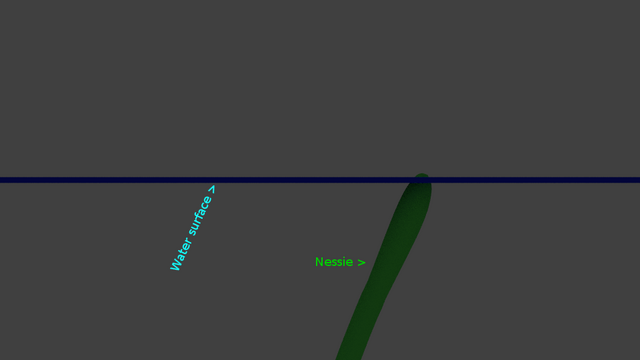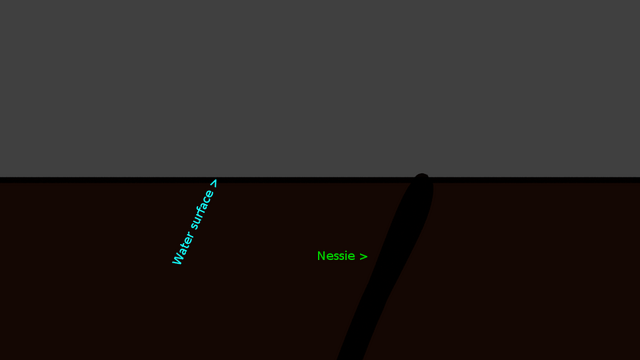Han
piscator ψ
Green = Trajanus
"I knew about the coelacanth, but a plesiosaur is not only bigger there's no way it could've survived in loch ness during the ice ages."
My understanding is that the current Loch Ness was actually formed during the last Ice Age (about 10,000 years ago) so I agree that it couldn't have survived in it's present location.
I am not sure if plesiosaurs were endotherms but I believe there is evidence to show that they lived in "cold" seas. I understand that the Leatherback Turtle (an extant marine reptile) can quite happily operate in freezing waters, in Alaska for example:
Leatherback Turtles: Cold Blood in Cold Water
For me the biggest issue with nessie is that if it is a Plesiosaur then it would have to breath air because they had lungs, most depictions I have seen show long neck plesiosaurs swimming with their long necks above the water, but maybe they operated at a greater depth and use their long neck like a snorkel on a submarine, Arapimah fish grow very large indeed and also breathe air, but when they come up for a gulp of air, very little of their body emerges above the surface of the water. Loch Ness is very murky making visibility poor especially from above to below water.
Another issue is how would it get into the Loch? because although the river Ness flows into the Loch (connecting it to the sea), it is quite small and a large animal would have trouble hiding in it.
Also if Nessie is an occasional "visitor" from the sea, I would expect one to have been caught in fishing nets by accident, but it is possible they eat a species that man does not fish for (possibly jelly fish?) meaning that the chances of "contact" are reduced. but then why would it be in Loch Ness? there are no jelly fish present. maybe it occasionally goes in the Loch looking for something it doesn't usually eat, like a particular water plant that it cant find at sea, or maybe it just likes the Loch? I know that Killer whales go to certain stony coves to play and rub off parasites. Certain large pelergic fish including sharks frequent "cleaning stations" where they are cleaned of parasites by small fish and they clearly understand the "mutual contract" and do not eat said cleaning fishes even when they enter their mouths, the same is true when oxpeckers and similar small birds clean a Crocodiles teath.
Maybe a brief stay in the fresh water of Loch Ness kills the marine parasites attached to Nessie?
To cut a long story short there are many reasons why an animal could be at any given location, even if it seems out of place.
Having said all that I am not convinced that there is a current Loch Ness monster, but I do entertain the possibility that one was seen in the distant past, and the legend preserved.
"There are also reports of "reptilian" aliens so I think ET is behind the dino sightings too. The coelacanth had remote seas to hide in but it's very hard o believe real dinosaurs survived 66 m.y. after chicxulub. Both cryptids and aliens have evaded real verification, but at least a superior civilization makes that seem credible."
I would go the opposite way, and say that an advanced civilization must have evolved from something, and as yet there is no evidence of even the lowest order of life present outside earth.
All speculation yes, and some would say that the probability of "ET" life is higher than the probability of there not being, but I remain sceptical.
If I was pushed, I would say that: I believe that in the future man will work out time travel, and there is a possibility some UFO's/and or Paranormal events are this.
"I knew about the coelacanth, but a plesiosaur is not only bigger there's no way it could've survived in loch ness during the ice ages."
My understanding is that the current Loch Ness was actually formed during the last Ice Age (about 10,000 years ago) so I agree that it couldn't have survived in it's present location.
I am not sure if plesiosaurs were endotherms but I believe there is evidence to show that they lived in "cold" seas. I understand that the Leatherback Turtle (an extant marine reptile) can quite happily operate in freezing waters, in Alaska for example:
Leatherback Turtles: Cold Blood in Cold Water
For me the biggest issue with nessie is that if it is a Plesiosaur then it would have to breath air because they had lungs, most depictions I have seen show long neck plesiosaurs swimming with their long necks above the water, but maybe they operated at a greater depth and use their long neck like a snorkel on a submarine, Arapimah fish grow very large indeed and also breathe air, but when they come up for a gulp of air, very little of their body emerges above the surface of the water. Loch Ness is very murky making visibility poor especially from above to below water.
Another issue is how would it get into the Loch? because although the river Ness flows into the Loch (connecting it to the sea), it is quite small and a large animal would have trouble hiding in it.
Also if Nessie is an occasional "visitor" from the sea, I would expect one to have been caught in fishing nets by accident, but it is possible they eat a species that man does not fish for (possibly jelly fish?) meaning that the chances of "contact" are reduced. but then why would it be in Loch Ness? there are no jelly fish present. maybe it occasionally goes in the Loch looking for something it doesn't usually eat, like a particular water plant that it cant find at sea, or maybe it just likes the Loch? I know that Killer whales go to certain stony coves to play and rub off parasites. Certain large pelergic fish including sharks frequent "cleaning stations" where they are cleaned of parasites by small fish and they clearly understand the "mutual contract" and do not eat said cleaning fishes even when they enter their mouths, the same is true when oxpeckers and similar small birds clean a Crocodiles teath.
Maybe a brief stay in the fresh water of Loch Ness kills the marine parasites attached to Nessie?
To cut a long story short there are many reasons why an animal could be at any given location, even if it seems out of place.
Having said all that I am not convinced that there is a current Loch Ness monster, but I do entertain the possibility that one was seen in the distant past, and the legend preserved.
"There are also reports of "reptilian" aliens so I think ET is behind the dino sightings too. The coelacanth had remote seas to hide in but it's very hard o believe real dinosaurs survived 66 m.y. after chicxulub. Both cryptids and aliens have evaded real verification, but at least a superior civilization makes that seem credible."
I would go the opposite way, and say that an advanced civilization must have evolved from something, and as yet there is no evidence of even the lowest order of life present outside earth.
All speculation yes, and some would say that the probability of "ET" life is higher than the probability of there not being, but I remain sceptical.
If I was pushed, I would say that: I believe that in the future man will work out time travel, and there is a possibility some UFO's/and or Paranormal events are this.








